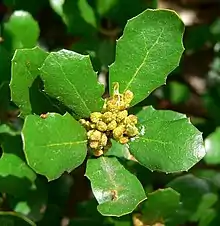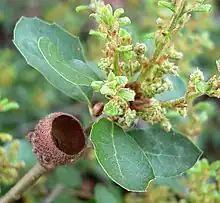Quercus pacifica
Quercus pacifica is a species of oak known by the common names island scrub oak, Channel Island scrub oak, and Pacific oak.
| Quercus pacifica | |
|---|---|
 | |
| Scientific classification | |
| Kingdom: | Plantae |
| Clade: | Tracheophytes |
| Clade: | Angiosperms |
| Clade: | Eudicots |
| Clade: | Rosids |
| Order: | Fagales |
| Family: | Fagaceae |
| Genus: | Quercus |
| Subgenus: | Quercus subg. Quercus |
| Section: | Quercus sect. Quercus |
| Species: | Q. pacifica |
| Binomial name | |
| Quercus pacifica Nixon & C.H.Mull. | |
| Synonyms[2] | |
| |
Description
Quercus pacifica is a shrub or a small tree growing up to 5 meters (16 feet) in height, or occasionally taller.[3]
The leaves are roughly oval in shape and edged with pointed teeth. The green blades are up to 4 centimeters (1+1⁄2 inches) long by 4 cm wide. They have shiny upper surfaces and waxy, hairy, glandular undersides.[3]
The acorn has a cap up to 2 cm (3⁄4 in) wide and a nut measuring 2 or 3 cm (3⁄4 or 1+1⁄4 in) long.[3]

This oak often produces a stable hybrid with Quercus lobata, that has been named Quercus × macdonaldii.[3]
Distribution
It is endemic to the Channel Islands of California, where it is known from the islands of Santa Cruz, Santa Rosa, and Santa Catalina. The islands of Santa Cruz and Santa Rosa are part of Channel Islands National Park.[4]
Though limited to three islands, it is not uncommon there, occurring in grassland, chaparral, oak woodlands, forest, and other habitat. It is the dominant oak in many areas on Catalina Island.[5] It was described as a new species in 1994 from a specimen collected on Santa Cruz Island.[6] More than a century earlier, the same plant was described as a variety of Quercus dumosa;[7] the 1994 name is nevertheless the correct name for the plant when recognized as a species because names hold priority status only within a given rank.[8]
Threats
This oak species is threatened by a pathogenic honey fungus (Armillaria sp.), which has been noted to infect trees already stressed by the activity of feral herbivores, including goats and pigs.[5]
A new species of fungus was discovered growing in oak galls on this oak species and was named Penicillium cecidicola in 2004.[9]
References
- "Quercus pacifica". IUCN Red List of Threatened Species. 2015. 2015. Retrieved 3 November 2017.
data
- "Quercus pacifica". World Checklist of Selected Plant Families. Royal Botanic Gardens, Kew – via The Plant List. Note that this website has been superseded by World Flora Online
- Nixon, Kevin C. (1997). "Quercus pacifica". In Flora of North America Editorial Committee (ed.). Flora of North America North of Mexico (FNA). Vol. 3. New York and Oxford: Oxford University Press – via eFloras.org, Missouri Botanical Garden, St. Louis, MO & Harvard University Herbaria, Cambridge, MA.
- "Quercus pacifica". Calflora. Berkeley, California: The Calflora Database.
- Knapp, D. A. (2002). The Status of Island Scrub Oak (Quercus pacifica) on Catalina Island, California. In: Standiford, R. B., et al. Proceedings of the Fifth Symposium on Oak Woodlands: Oaks in California's Challenging Landscape. Gen. Tech. Rep. USDA Forest Service.
- Nixon, K. C.; Muller, C. H. (1994). "New names in California oaks". Novon. 4 (4): 391–392. doi:10.2307/3391450. JSTOR 3391450.
- Greene, Edward Lee. 1889. Illustrations of West American Oaks 36, 61, plate 28
- International Code of Nomenclature for algae, fungi, and plants (Melbourne Code) section 11.2
- Seifert, K. A., et al. (2004). Penicillium cecidicola, a new species on cynipid insect galls on Quercus pacifica in the western United States. Studies in Mycology 50 517-23.
External links
- Jepson eFlora, The Jepson Herbarium, University of California, Berkeley
- The Nature Conservancy
- Quercus pacifica in the CalPhotos photo database, University of California, Berkeley
